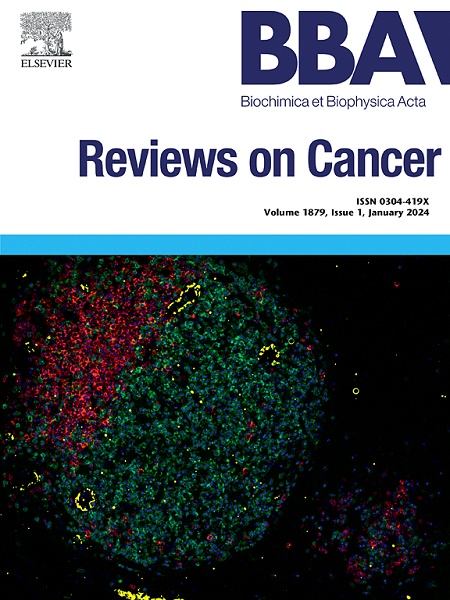PARP1: A comprehensive review of its mechanisms, therapeutic implications and emerging cancer treatments
IF 9.7
1区 医学
Q1 BIOCHEMISTRY & MOLECULAR BIOLOGY
Biochimica et biophysica acta. Reviews on cancer
Pub Date : 2025-02-11
DOI:10.1016/j.bbcan.2025.189282
引用次数: 0
Abstract
The Poly (ADP-ribose) polymerase-1 (PARP1) enzyme is involved in several signalling pathways related to homologous repair (HR), base excision repair (BER), and non-homologous end joining (NHEJ). Studies demonstrated that the deregulation of PARP1 function and control mechanisms can lead to cancer emergence. On the other side, PARP1 can be a therapeutic target to maximize cancer treatment. This is done by molecules that can modulate radiation effects, such as DNA repair inhibitors (PARPi). With this approach, tumour cell viability can be undermined by targeting DNA repair mechanisms. Thus, treatment using PARPi represents a new era for cancer therapy, and even new horizons can be attained by coupling these molecules with a nano-delivery system. For this, drug delivery systems such as liposomes encompass all the required features due to its excellent biocompatibility, biodegradability, and low toxicity. This review presents a comprehensive overview of PARP1 biological features and mechanisms, its role in cancer development, therapeutic implications, and emerging cancer treatments by PARPi-mediated therapies. Although there are a vast number of studies regarding PARP1 biological function, some PARP1 mechanisms are not clear yet, and full-length PARP1 structure is missing. Nevertheless, literature reports demonstrate already the high usefulness and vast possibilities offered by combined PARPi cancer therapy.
PARP1:其机制,治疗意义和新兴癌症治疗的综合综述。
聚(adp -核糖)聚合酶-1 (PARP1)酶参与了与同源修复(HR)、碱基切除修复(BER)和非同源末端连接(NHEJ)相关的几种信号通路。研究表明,PARP1功能和控制机制的失调可导致癌症的发生。另一方面,PARP1可以成为最大化癌症治疗的治疗靶点。这是由可以调节辐射效应的分子完成的,比如DNA修复抑制剂(PARPi)。利用这种方法,肿瘤细胞的活力可以通过靶向DNA修复机制来破坏。因此,使用PARPi的治疗代表了癌症治疗的新时代,甚至可以通过将这些分子与纳米递送系统相结合来实现新的视野。为此,脂质体等药物输送系统由于其优异的生物相容性、生物可降解性和低毒性而具有所有必需的特性。本文综述了PARP1的生物学特征和机制、其在癌症发展中的作用、治疗意义以及parpi介导的新癌症治疗方法。尽管对PARP1的生物学功能有大量的研究,但PARP1的一些机制尚不清楚,缺少PARP1的全长结构。尽管如此,文献报道已经证明联合PARPi癌症治疗具有很高的实用性和巨大的可能性。
本文章由计算机程序翻译,如有差异,请以英文原文为准。
求助全文
约1分钟内获得全文
求助全文
来源期刊

Biochimica et biophysica acta. Reviews on cancer
医学-生化与分子生物学
CiteScore
17.20
自引率
0.00%
发文量
138
审稿时长
33 days
期刊介绍:
Biochimica et Biophysica Acta (BBA) - Reviews on Cancer encompasses the entirety of cancer biology and biochemistry, emphasizing oncogenes and tumor suppressor genes, growth-related cell cycle control signaling, carcinogenesis mechanisms, cell transformation, immunologic control mechanisms, genetics of human (mammalian) cancer, control of cell proliferation, genetic and molecular control of organismic development, rational anti-tumor drug design. It publishes mini-reviews and full reviews.
 求助内容:
求助内容: 应助结果提醒方式:
应助结果提醒方式:


